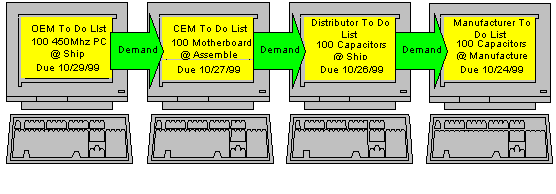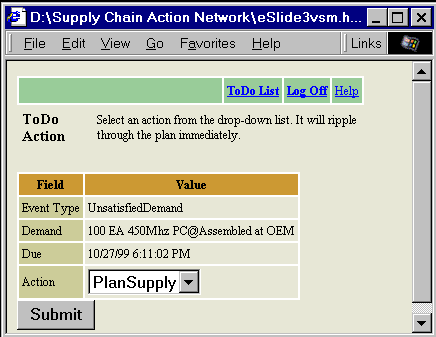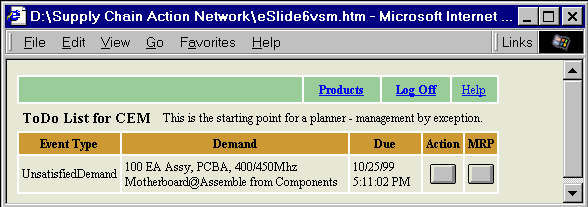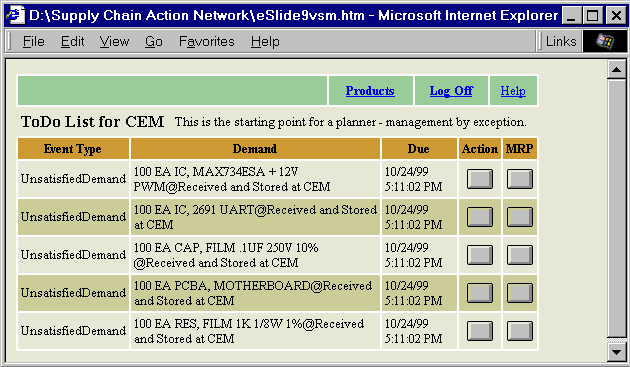Enterprise Application Integration systems like Vitria have a
cross-company messaging component that can keep up with the actual events
of the real-world supply chain.
But EAI systems are still usually lacking some of the key features of
an REA model:
Most EAI systems provide a scripting language and a scriptable object
model, so it would be possible to create an REA supply chain model using
the EAI system. However, once again, the EAI scriptable object models are
proprietary.
Walid Mougayar's perceptive analysis contrasts with the cheerleading
going on in most other current B2B writings, for example BusinessWeek.
If Ford and GM use two different B2B systems - as BusinessWeek
uncritically exclaims - what does Bosch do, who supplies both of them and
Toyota, Nissan and Daimler-Chrysler as well?
How about XML-EDI, eCO, RosettaNet,
etc?
Each of these groups represents an attempt to develop a non-proprietary
Internet standard for business-to-business ecommerce. To that extent, they
are moving in the right direction.
However, none of these initiatives has a semantic supply chain model
with anywhere near the breadth and depth of REA.
All of these Internet B2B e-commerce "standards" have focused on
purchasing (in other words, Exchanges in the REA model (see below)). But
there is a lot more to the world than purchasing: there is also
manufacturing, and transportation, and all of the links between all of the
processes in the supply chain.
Purchasing is a point-to-point relationship between two companies, and
it cannot give an overview of a supply chain. The action is in the whole
supply chain, not just two isolated points.
Some of these initiatives (for instance eCo) have richer models that
could easily accommodate an REA supply chain model. The proposal for REA
standardization below recommends building an REA-XML model on top of one
or more of these initiatives. Of course, it would be easier if there
weren't so many of these "standards"...
REA is the best
REA is the best model for Internet supply chain collaboration
because:
- REA is a public-domain, non-proprietary model - anyone may use it
without restriction;
- REA models can cover whole supply chains across multiple companies;
- the REA model handles all kinds of activities - manufacturing,
transportation, purchasing, etc., and all of the links between
activities - in a uniform way;
- an REA semantic Web can maintain persistent links across all
activities in a multi-company supply chain until the chain's work is
done;
- the REA model handles all resources – products, cash, labor,
machines – in a consistent way;
- an Internet-hosted REA supply chain model can communicate
information across multiple companies in any direction in seconds, not
days or weeks;
- because events are REA’s middle name, an REA supply chain model
readily accomodates an event-driven business system (see REA supply chain in
action below);
- the REA model has been validated for correctness by peer review in
the leading accounting journals, and accounting is among the most
meticulous of business professions;
- the REA model accommodates continuous updates of accounting and
performance reports of any kind, as in Cisco Corporation’s "virtual
closing" where business managers can get instant business overviews that
drill down to details;
- an REA model can encapsulate other business models and use them as
subsidiary components;
- an REA semantic Web would not need to be developed all at once, in
an impossible engineering feat – it can be developed by piecemeal
growth, as long as a core standard is preserved;
- an REA supply chain model can either work well with other systems,
like EAI, or it can grow into the whole business system on its own, for
a seamless combination of supply chain and enterprise systems;
- an REA model can perform planning functions like MRP and APS itself,
or it can delegate these functions to other systems.
How does REA work?
REA works by give and take. Remember the acronym: Resources, Events and
Agents. In an economic Event, an economic Agent gives one economic
Resource (for example, a product) and takes in return a different economic
Resource (for example, cash).
In an REA economic exchange between two companies, the Supplier agent
gives a product, which is taken by the Customer agent. In return, the
Customer agent gives cash, which is taken by the Supplier agent.

In an REA production process, components, labor and machine time,
energy, etc. are given (consumed, input) , and completed products are
taken (produced, output) in return.

REA activities are either Exchanges, which trade Resources between
Agents; or Processes, which consume input Resources and produce output
Resources.
REA activities are connected by Stock Flows, which represent one
Resource moving from one activity to the next.

In planning, one Stock Flow represents one dependent demand or one line
item if you want to think in terms of orders.
By means of these simple components, REA can represent any business
process. You can put orders on top of REA (Exchanges = purchase and
customer order line items, Processes = work orders) but REA does not
require orders. REA was designed for computer-to-computer communication –
not to mimic paper systems.
There is a lot more to making a whole system out of REA components, but
the basic components are very simple – a lot simpler than ERP systems.
Which means that REA software can also be simpler to develop and
implement.
Also, because all REA activities are uniform and connected by Stock
Flows, information flows can be fast and simple.
Remember the ERP information flow?
PO->EDI->CO->MPS->MRP->CRP->WO->PO->EDI->CO
etc.
The REA information flow is much simpler:
Process->Stock Flow->Exchange->Stock Flow->Process etc.
across multiple companies.
Or, in acronym form:
P->F->X->F->P etc.
Each Event on an REA supply chain knows what other events it is
connected to, via the Stock Flows.
Changes, such as demand or schedule changes, can ripple across the
Flows to all affected Agents.
Each Stock Flow has one or more roles for Agents.
The Responsible Agent is responsible for handling Events that require
human judgment. In an Internet-hosted REA network, these Events would
arrive at the Agent’s ToDo List with a set of Feasible Actions that could
be selected by a mouse click.
Each Agent can be accountable to superior Agents, giving an
organizational structure. The superior Agents may be notified of
subordinate activities that they wish to monitor. A Superior Agent can
have a near-real-time overview of all business events in her span of
control.
REA Processes can be nested: for example, one Process at the supply
chain level can expand into all of the activities in a manufacturing plant
at a lower level. This process-nesting allows each level of an REA supply
network to be relatively small, but contain all the required detail at
lower levels by dividing and conquering.
An REA supply chain in
action
Logistical Software LLC was formed to develop Internet supply chain
software based on the REA model. Here are some screen shots from
Logistical’s Supply Chain Action Network.
First is the Business Model. The model depicted is for a computer
supply chain.
There are two main sections to the model: Agents (called Parties in
this model) and Resources. Only Product resources are shown here. The
Party section of the model has more hidden detail in the form of an
organization chart with positions and employees.
The Resource section also contains the business model for Processes and
their input and output Stock Flows. Note that the business model contains
multiple companies, and the process flows span all of the companies.

Interactions between the participants in the supply chain is very
simple: each party works off an Internet ToDo List. Because REA is an
event-driven system, users mostly just respond to business events. Rules
can be set up to handle some events automatically. Other events are put on
ToDo Lists for human judgment.
The different ToDo Lists are connected by REA Stock Flows on which
dependent demands and other business transactions travel, for example:

Here we see the ToDo List for the OEM supply chain planner. There is
one unsatisfied demand to deal with. This business event came to the OEM
planner automatically, over an REA Stock Flow link from another
process.

The OEM planner takes action, planning a supply process for the
required PCs. No orders are needed.
When the Submit button is clicked, dependent demands will be instantly
propagated to the next agents in the chain.

Here a dependent demand for motherboards to be assembled shows up on
the Contract Electronics Manufacturer’s ToDo List. When the CEM takes
action, more dependent demands will be sent to the next agents, etc. Rules
can be set up to propagate transactions automatically where human judgment
is not needed, bypassing ToDo Lists altogether.
All information flows move across companies very quickly. Changes and
problem alerts move from agent to agent in the same way that demands flow.
Everything is connected by REA Stock Flows in the background.
These interconnected ToDo Lists amount to a multi-company workflow
system driven by business events.
But it is different from most workflow systems, which are really just
document flows that route a document around until it is completed. The REA
Stock Flows generate the next dependent events triggered by the current
event. For example, the Motherboard demand triggers the dependent demand
for the Motherboard components.


You can see more of this flow at http://www.supplychainlinks.com/
Conclusion
REA is a superior accounting model, but its popular acceptance has been
held back by the conservativism of the accounting profession. (Needless to
say, accountants are conservative for good reasons, among them legal
constraints.)
Internet supply chain collaboration and Internet trading communities
may be a more fertile field for the REA model to gain popular acceptance.
The REA model is much better than any competing semantic model for
multi-company supply chain collaboration. The Internet as a means of
coordination is driving supply chain collaboration very quickly, but there
is no accepted standardized semantic model that can actually encompass all
supply chain activities. A standard, non-proprietary semantic model can
make supply chain collaboration more like a public utility (the semantic
Web) that businesses plug into than the current slow and expensive
collaboration projects.
REA can become the semantic Web for supply chains. But it will take the
concerted efforts of the REA community (and new recruits) to make it
happen. This paper is intended to further that effort.
References
 Business
Object Component Workshop VI: Enterprise Application Integration
Business
Object Component Workshop VI: Enterprise Application Integration Business
Object Component Workshop VI: Enterprise Application Integration
Business
Object Component Workshop VI: Enterprise Application Integration